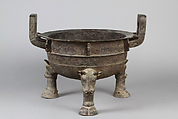On loan to The Met The Met accepts temporary loans of art both for short-term exhibitions and for long-term display in its galleries.
Ritual ox tripod (niuding)
This large cauldron was cast for Emperor Huizong’s use at the altar of the Grand Chamber (Taishi), the Imperial Ancestral Temple. Its three-legged shape and the stylized wave pattern encircling its body emulate an archaic bronze, while ox heads atop each of the legs reference a contemporary ritual practice recorded in the tenth-century manual Sanli tu (Illustrations to the three classics on rites); it describes three types of cauldrons (with animal-head ornaments) as containers for the three sacrificial animals—ox, lamb, and pig. The vessel demonstrates that, in addition to rigorously studying past models, Emperor Huizong’s craftspeople incorporated design elements that reflected contemporary conventions. Said to have been unearthed in around 1500, the tripod was well documented by antiquarians in the following enturies
Inscription
惟甲午八月丙寅, 帝若稽古, 肇作宋器, 審厥象, 作牛鼎, 格於太室, 迄用享, 億寧神休, 惟帝時寶, 萬世其永賴。
On the bingyin day of the eighth lunar month of the jiawu year [of the Zhenghe reign], the emperor investigated antiquity and took the initiative to make ritual vessels. He described the appearance of an “ox” ding tripod and made this for the Great Chamber to be used for offering peace and blessings. May it be eternally treasured and used for all time.
This image cannot be enlarged, viewed at full screen, or downloaded.
This artwork is meant to be viewed from right to left. Scroll left to view more.



